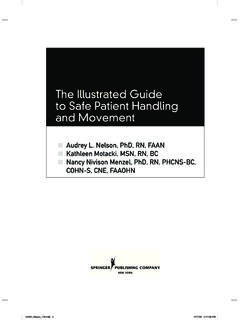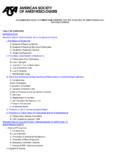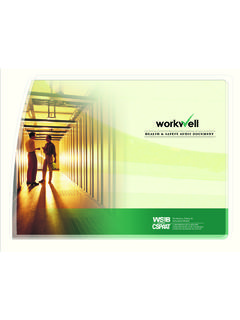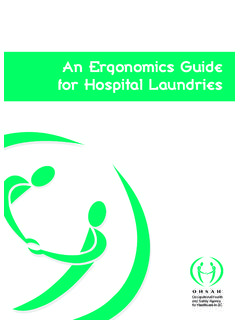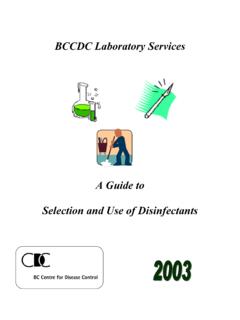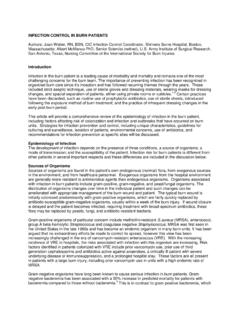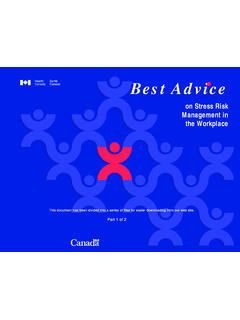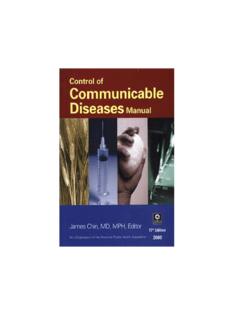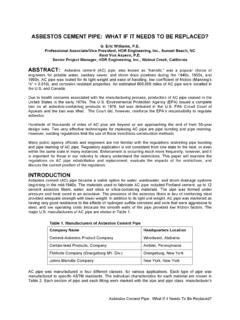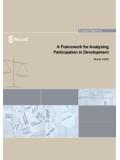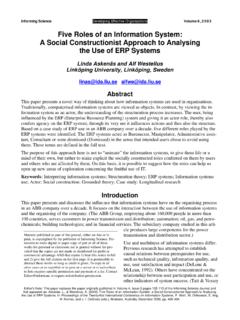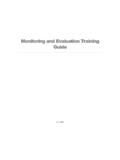Transcription of Job Safety Analysis Made Simple - Christopher …
1 Job Safety Analysis made Simple ISBN 0-660-18606-3. DSS Catalogue Number CC273-2/01-4E. CCOHS 2001. This publication is a joint production of the Canadian Centre for Occupational Health and Safety and Human Resources Development Canada, Labour Program Summary In every Canadian jurisdiction, health and Definitions Safety legislation holds employers account- able for ensuring the health and Safety of In this publication, hazard and risk are their employees. Employers are responsible defined as follows: for assessing the health and Safety risk Hazard means anything that can cause harm. (chance that somebody will be harmed) of a Examples of hazards include toxic chemicals, job. Based on this assessment, employers moving machinery parts, high-voltage must implement Safety measures to eliminate electricity, working on heights, temperature or mitigate any risks to their employees. Job extremes, slippery work-surfaces. Safety Analysis (JSA) is a proactive approach to ensuring health and Safety in the workplace.
2 Risk means the chance that someone will be The JSA process provides a way of identify- harmed by the hazard. ing job-related hazards and determining preventive measures. This involves carefully analysing each task of a job, identifying potential health and Safety hazards at each step, and determining practical ways of preventing or mitigating such hazards. These preventive measures can then be integrated into an employer's work practices and procedures for the job. This publication outlines the basic concept of JSA and provides a step-by-step proce- dure for performing a JSA according to two Simple techniques: change Analysis and the energy barrier approach (see the flow chart on the next page). Examples of job Safety Analysis for some common jobs are present- ed. These examples are intended to illustrate the application of JSA and do not necessarily include a comprehensive list of all potential hazards and related preventive measures. In addition, compliance with applicable occu- pational health and Safety regulations must be considered as a part of the overall JSA.
3 I. Job Safety Analysis Flow-Chart The following flow-chart illustrates steps involved in Job Safety Analysis (JSA). II. Table of contents Introduction.. 1. 1. What is a Job Safety Analysis (JSA) ..2. 2. How to perform a Job Safety Analysis (JSA) .. 3. Step 1: What important factors should be considered in selecting a job for JSA? .. 3. Step 2: How are the basic tasks of a job established? .. 3. Step 3: How are the potential hazards identified? .. 5. Step 4: How are preventive measures determined? .. 12. Step 5: How should I communicate the JSA information to everyone else? .. 17. 3. How and when to use Job Safety Analysis (JSA) .. 18. 4. Follow-up and Review of a Job Safety Analysis (JSA).. 19. 5. References .. 20. 6. Examples of Job Safety Analysis (JSA) .. 21. 1. Transportation of dangerous goods (TDG).. 22. 2. Climbing trucks to inspect levels of substance in snow and rain .. 24. 3. Handling of heavy objects in ports and storage .. 26. 4. Machine maintenance .. 28. 5. Working at heights on communication towers.
4 30. 6. Improvisation of tasks.. 32. Appendix A: Sample form for Job Safety Analysis (JSA) .. 34. Appendix B: Step-by-step Instructions for Job Safety Analysis (JSA) .. 35. Appendix C: Practical Tips for Performing Job Safety Analysis (JSA) .. and its Implementation .. 36. III. Introduction Background Target Audience Employers are responsible for ensuring the This publication is intended for workers, health and Safety of their employees. This managers and supervisors, members of includes informing employees of workplace health and Safety committees, and health hazards, providing the equipment necessary and Safety representatives. Health and Safety to safeguard health and Safety , and establish- professionals will find this publication a ing proper health and Safety procedures and practical tool for workplace training sessions practices. Therefore, employers have an on health and Safety programs and policies. obligation to assess health and Safety risks and to develop Safety procedures that will eliminate or mitigate these risks before an employee is required to carry out work.
5 This publication outlines job Safety Analysis (JSA) as a method of identifying potential hazards and developing safe work practices to prevent injuries, illnesses, property damage and other losses. Scope This publication introduces the concept of job Safety Analysis and outlines two practical methods of identifying potential hazards and applicable preventive measures. It stimulates the thinking process and empowers the reader to perform job Safety Analysis . Examples of Analysis are included to illustrate the process. The presentation level is narrative and does not require solving mathematical formulas. The level of presentation is suited for persons who are familiar with the workplace but are not necessarily health and Safety experts. 1. 1. What is a Job Safety Analysis (JSA)? Job Safety Analysis (JSA) is the systematic Health and Safety committee members and examination of a job intended to identify representatives play an important role in the potential hazards, assess the degree of risk, and JSA and have a legal obligation to participate evaluate practical measures to control the risk.
6 In the JSA process. They also provide practical It must be kept in mind that JSA is not a work experience related to the risk evalua- workplace inspection or an audit procedure. tion and the feasibility of appropriate Workplace inspection is a systematic controls. Health and Safety specialists may examination of workplace conditions and participate in the JSA to eliminate any over- practices to determine their conformity with sight in accounting for potential hazards and company procedures and compliance with related preventive measures. prescribed health and Safety regulations. An Some individuals prefer to expand the audit process is a systematic examination of Analysis into all aspects of the job, not just the Safety management system to determine Safety . This approach is known as total job if work activities and related results comply Analysis or task Analysis . The total job analy- with planned prevention policies and estab- sis is based on the concept that Safety is an lished programs.
7 As well, an audit evaluates integral part of every task performance and whether the program is effective in achieving not a separate entity. In this document, only the goals and objectives set out in the policy. health and Safety aspects will be considered;. A JSA should be proactive, although it may however, it is recognized that this material be used in response to a rising rate of could be used to conduct a total job Analysis . injuries and illnesses. Hazards should be recognized and preventive measures imple- mented at the planning and organizing stages of the work. It should be emphasized that the focus of JSA is to examine the job and not the person who is doing the job. Job Safety Analysis is an important element of a risk management system. It involves analysing each basic task of a job to identify potential hazards and to determine the safest way of doing the job. This procedure is sometimes referred to as job hazard Analysis . Experienced workers and supervisors may perform a JSA by analysing jobs through discussion and observation.
8 This approach has two distinct advantages. Firstly, it involves more people which allows for a wider base of experience. Secondly, the participation of many stakeholders promotes faster accep- tance of the resulting work procedure. 2. 2. How to perform a Job Safety Analysis (JSA). A job Safety Analysis involves Potential for severe injuries or illnesses: five steps: the consequences of an accident, hazardous condition, or exposure to 1. Selecting the job to be analysed. a harmful substance are potentially 2. Breaking the job down into a sequence severe. of tasks. Modified jobs: new hazards may be 3. Identifying potential hazards. associated with changes in job procedures/processes. 4. Determining preventive measures to control these hazards. Infrequently performed jobs: employees may be at greater risk when undertaking 5. Communicating the information non-routine jobs. to others. Jobs with frequent work interruptions due to technical difficulties. STEP 1: Jobs with excessive waste generation and production losses.
9 What important factors should Jobs where employees are required to be considered in selecting a job work alone in isolated workplaces. for JSA? Jobs with the potential for violence in Ideally, a JSA should be performed for all workplace. jobs. However, there are practical constraints on time and resources. Another consideration is that each JSA may require revision when STEP 2: changes occur in equipment, raw materials, processes, or the environment. For these How are basic tasks of a job reasons, it is usually necessary to set priori- established? ties. Factors to be considered in assigning priorities include: A task is a segment of an overall job. Completion of each operational task in Accident, injury and illness statistics: proper sequence leads to the completion of jobs where accidents occur frequently the job. It is important to keep the tasks in or where they result in disabling their correct sequence. Any task which is injuries or illnesses. placed out of sequence may cause potential Absenteeism: jobs where employees take hazards to be missed or introduce hazards frequent sick leaves or other leaves of which would not otherwise exist.
10 Absence. When conducting a JSA each task is record- Signs and symptoms of harmful expo- ed in its proper sequence. Notes should be sures: the nature of the job poses a dan- made of what is to be done rather than how ger of harmful exposure. it is done. Each item is started with an action verb. 3. Appendix A illustrates a format that can be This part of the Analysis is usually prepared by used as a worksheet for JSA. watching the employee do the job. The Dividing a job into tasks requires a thor- employee being observed should be experi- ough knowledge of the job. If the tasks are enced and capable of performing all parts of made too general, specific operations and the job. The observation team may include related hazards may be missed. On the other the immediate supervisor, a health and Safety hand, too many tasks may make the JSA professional, and a member of the health and impractical. A rule of thumb is that most Safety committee or the health and Safety rep- jobs can be described in less than ten tasks.
